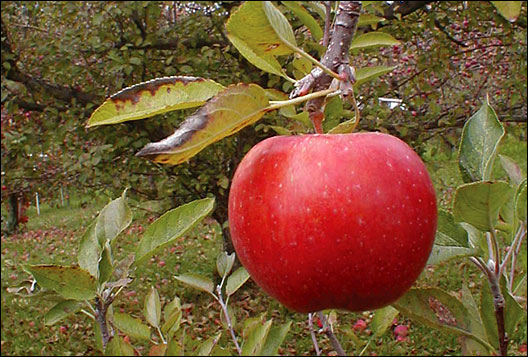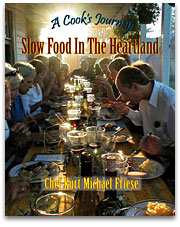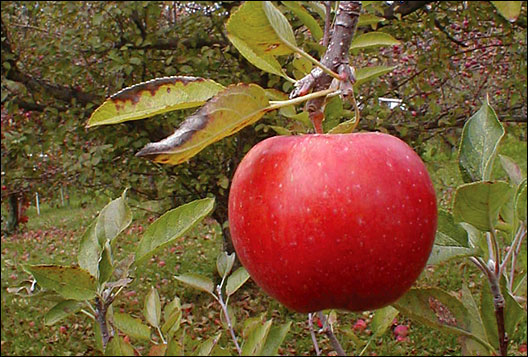This column is an excerpt from Friese’s new book A Cook’s Journey: Slow Food in the Heartland.

One cool spring morning about 1880, a farmer in Madison County, Iowa, named Jesse Hiatt was walking the rows of his young orchard when he noticed a chance seedling growing between the rows. An orderly man, he preferred that his trees grow in an organized fashion, and he chopped the seedling down. The seedling grew back the following year, and so he chopped it down again. When the seedling sprouted back up a third time, legend has it Mr. Hiatt said to the tree, “If thee must grow, thee may.”
Hiatt nurtured the tree for 10 years. When it finally came to fruition, Hiatt was pleased with the red and yellow streaked appearance and the sweet, impressive flavor. He named it the Hawkeye after his adopted home state and began to seek a nursery to propagate his discovery. Eight or 10 of them turned him down before his big break came.
He sent some of the fruit to a contest in Louisiana, Missouri, which was seeking new varieties of fruit trees, especially apples. The Stark Brothers Fruit Company held the competition as part of their search for an apple tree to replace the then-most-popular tree, the Ben Davis. The Ben Davis apple had a nice appearance and was durable in shipping and weather-hardy but lacking in flavor. When Clarence Stark tasted the apple with the unusual oblong shape and the distinctive five bumps on the bottom, he pronounced it “Delicious!” Unfortunately, due to some poor record keeping, Hiatt’s name and address were lost, and it wasn’t until Hiatt reentered the competition the following year that his Hawkeye was officially declared the winner.
The Stark Brothers Fruit Company bought the rights to Hiatt’s discovery and began taking cuttings from the original tree at Hiatt’s Winterset farm. Study led them to the conclusion that this new variety was probably the result of an accidental cross of two very old varieties, the Bellflower and the Winesap. Sixty years later, Stark had sold more than 10 million trees worldwide that were all descendants of that original tree. They had renamed Hiatt’s Hawkeye after Clarence Stark’s original pronouncement, and the Delicious apple was on its way to becoming the most popular apple variety in the world.

A Cook’s Journey: Slow Food in the Heartland, by Kurt Michael Friese
Back in Winterset, the original tree continued to flourish in a state that was second only to Michigan in apple production. In 1940, on Armistice Day, a ferocious ice storm leveled Iowa’s orchards, a blast from which Iowa’s apple industry would never fully recover. With orchards being expensive to replant and war on the horizon, most orchards were turned into corn and soybean fields. Hiatt’s Hawkeye was split in two during the storm, and newspapers and radio commentators across the state lamented the demise of the historic tree. As Hiatt had noted all those years ago, though, this little tree “must grow.” The following spring it sent up a new sprout, phoenix-like, right from the middle of the split and thrives to this day not far from the historic covered bridges in Madison County. It has a monument to it, a fence and a private horticulturist to protect it, as well as a festival in its honor in Donnellson, Iowa.
Today, the fruit that bears the Delicious name bears little resemblance to that original Hawkeye. The yellow streaks are gone, replaced by a bright red shine. They are bred for shelf life, durability, and crunch but have lost their original flavor. How ironic that it now resembles the very same attributes of the Ben Davis that led Stark to seek a replacement.
Through the efforts of the Leopold Center for Sustainable Agriculture at Iowa State University and the Seed Savers Exchange in Decorah, Iowa, cuttings from the original tree have been propagated. At Wilson’s Orchard in Iowa City, owner “Chug” Wilson’s Hawkeye trees have been bearing fruit since 2002, and visitors can pick those apples along with many dozens of other varieties at Wilson’s every fall. One can even enjoy a piping hot apple turnover while strolling through the scenic orchard or enjoy a guided tour on a wagon towed by Chug himself in his big-brimmed hat.
Strolling amidst the well-tended rows of apples, you can feel almost instantly at peace. There is no traffic noise, no blaring advertisements, no background static — only the occasional tickling buzz of a honeybee flying by to see who is appreciating her work. In mid- to late October, the trees are usually heavy-laden with yellow, blush, red, and gold. Chug Wilson called the 2006 crop “a limb-buster,” which was a welcome relief after 2005’s disastrous late-spring freeze, which wiped out the blooms on Wilson’s trees and left them with a harvest of zero. In 2007, the blossoms froze again.
“We had to import apples from Wisconsin [to sell in the orchard store],” Chug told me during that visit. “Never had to do that before.”
Like all farming, growing apples is a very challenging undertaking, subject to the whims of weather, the market, insects, environment, and urban sprawl. Joyce and Chug Wilson know these challenges all too well and have had plenty of offers from land developers to plow their trees under in favor of zero-lots or split-level ranches. They’ve been tempted but have never relinquished the land. It’s far too valuable to them as it is, which you can see when you catch the glint in Chug’s eye when he so much as talks about his apples or when you see Joyce pull her magnificent apple turnovers from the oven in the orchard store.
The idea behind their effort to preserve and revitalize the original Hawkeye apple is not only to acknowledge the important contribution that it made to the apple industry, but also to insure that a particular flavor — one of 140 varieties on Wilson’s 80 acres — is not lost forever.
Apple-Pecan Stuffing
The original Hawkeye apple held up to cooking better than its modern-day descendant, but if you cannot get Hawkeyes in your area, many other heirloom apples work well. Visit your local orchard. This stuffing is delicious on its own or can be stuffed into a pork chop topped with caramelized onions for a great seasonal entrée.
2 cups chopped Hawkeye or Granny Smith apples (about 4 apples)
3/4 cup pecans, dry-roasted
1 yellow onion, diced
1 stalk celery, diced
2 tablespoons fresh sage
1 tablespoon salt
1 tablespoon cracked black pepper
1 loaf French bread, diced
1 quart homemade chicken stock
Melt the butter in a large sauté pan over medium high heat. Sauté the apples, pecans, onion, and celery in the sauté pan until just tender. Add the sage, salt, and pepper. Add the bread and mix thoroughly. Add the stock a little at a time until it is absorbed and the stuffing reaches the desired consistency (all a matter of taste, really; you may need more or less stock).
Cool to use as an actual stuffing, or to serve as a side dish, put in a shallow buttered casserole dish and bake about half an hour at 350 degrees F until crisp and crusty on top.
Makes enough to stuff a 12-15 pound turkey or serve 6-8 as a side dish.


